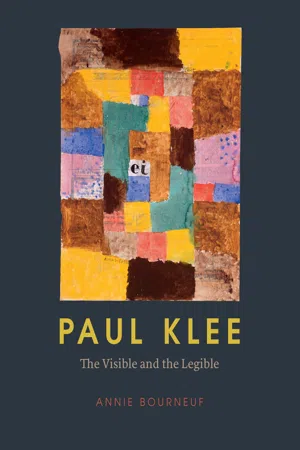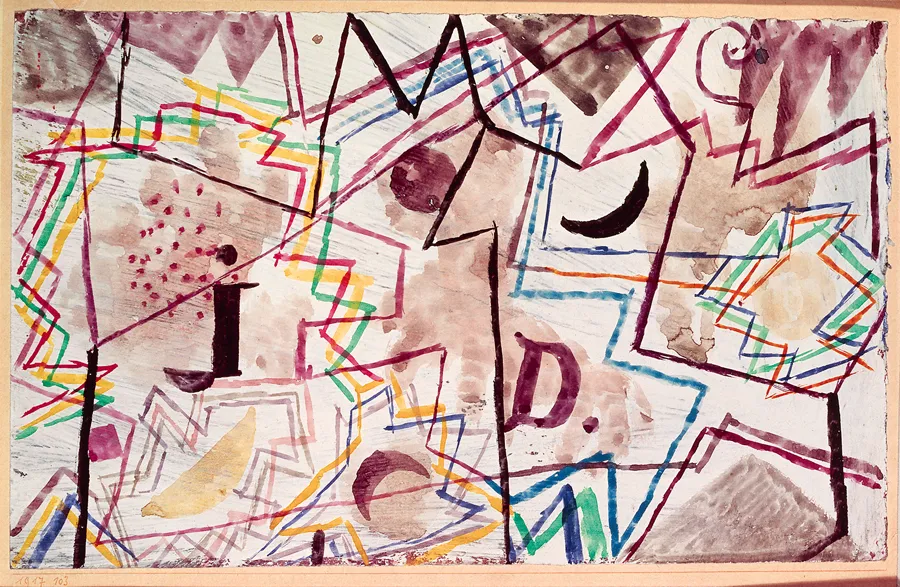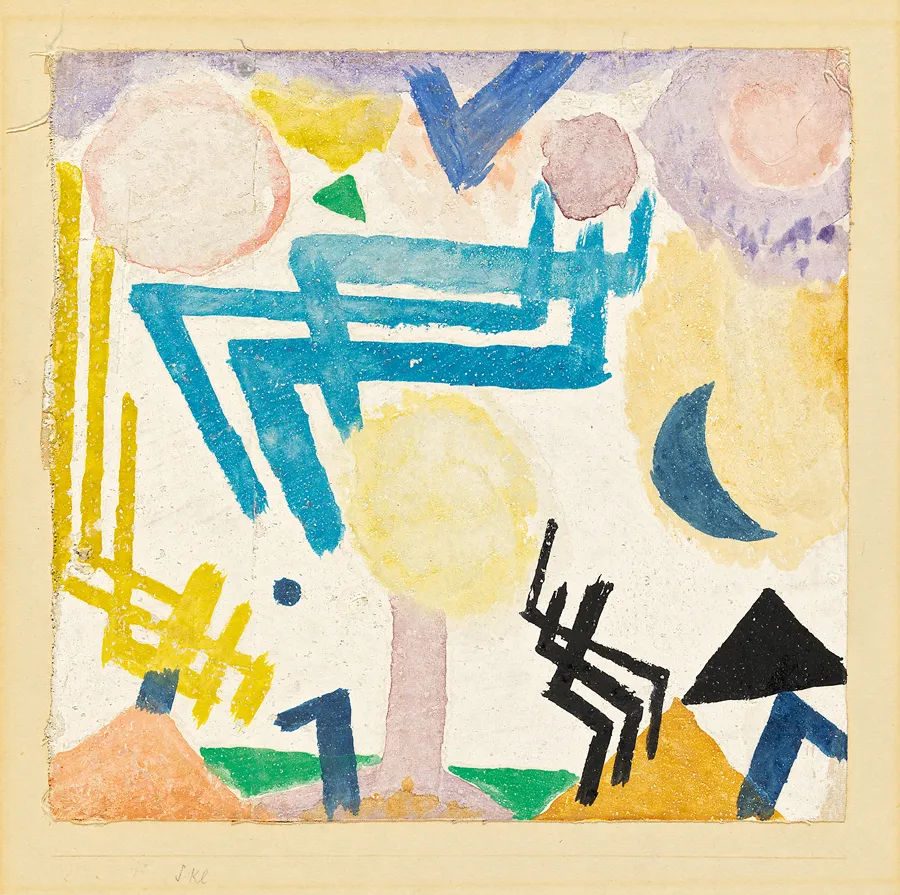![]()
1
The “Painter-Draftsman”
On September 9, 1917, Paul Klee reported in a letter to his wife Lily that he had left the accounting office of the military flying school in Gersthofen, where he worked as a clerk, at around noon to spend the rest of the day painting watercolors outdoors, in the fields around the Lech River. He wrote that three of his watercolors turned out well, truly “seizing” him, and then asked what connection might obtain between his art and the changes the war imposed on his life: “If I’d calmly gone on living, would my art have shot up so fast as in the year 16/17??”1
This is a version of one of the questions that this chapter seeks to answer, although I will not stay within the terms of Klee’s letter. Although it passed unremarked for decades in the literature, there is, in fact—as Klee notes—a striking change in his work in 1916–17. In this chapter, I argue that this change should be understood as Klee’s shift away from the dominant practices and theories of abstraction in the avant-garde circles around him, which were centered on painting, to a practice and theory of abstraction centered instead on graphic art. The consequences of this shift should not be underestimated: Klee’s revision of abstraction as graphic fundamentally alters his art and the kind of viewing it invites, and by following it we can discern connections between seemingly unrelated aspects of Klee’s art of the late 1910s, seeing how they hang together as a solution of sorts to problems arising from his reservations about some of the foundations of modernism—and how both far-reaching and unstable this solution was. But my first task is simpler: it is to establish that there was indeed a shift in Klee’s art around 1916, a step that is necessary because it has so often been overlooked.
I will begin with an overview. In 1916 and 1917, Klee developed a new mode of working, upon which he then elaborated over the next couple of years. His work assumed the form of a sprawling profusion of what he called Blätter (leaves, sheets, or pages)—drawn and watercolored pictures on very small pieces of paper or cloth (often scavenged bits of airplane linen), seldom more than a foot long in either dimension and almost always mounted on board. Klee often covered these supports with thin, roughly applied coats of plaster, lending the watercolors a gouache-like, light-reflecting brilliance; in the case of his scrappy cloth supports, he often applied the white ground roughly, emphasizing rather than smoothing over the texture of the cloth, and frayed the edges, which stand out against the mounts. He often inscribed the mount with an allusive, suggestive title underneath the picture, like the caption of an illustration. The pictures swarm with little signs—stars, crescents, hearts, and so on—which seem just as repeatable as the letters with which they are often interspersed. The allusive titles and little signs we can find in many of Klee’s drawings from earlier in the decade, but it is only in 1916 that they frequently enter his watercolors.2 We can see some of these features in what might be the three watercolors he speaks of in his letter of September 9: Play of Forces of a Lech Landscape (1917, 102), J.D. (1917, 103), and Landscape Hieroglyph with Emphasis on Sky-Blue (1917, 104) (figs. 1.1, 1.2, and 1.3).
These features do not always coincide (these three Blätter, for instance, have no “captions”) but they hold together with enough coherence to constitute a recognizable type in Klee’s production—and one that dominates his work from 1916, when he was drafted into the German infantry reserves, to 1919, when he was demobilized. Moreover, it was the first exhibition of the Blätter in February 1917 that marked Klee’s critical and commercial breakthrough. This exhibition—Klee’s second solo show at Herwarth Walden’s Sturm Gallery in Berlin, then the central point for the promotion of international modern art in Germany—suddenly established him as a major artist.3 In his review of the exhibition in the Berliner Börsen-Courier, the critic Theodor Däubler called Klee “the most important painter of the expressionist tendency”: “His exhibition is really staggering; it is unbelievable how much he has deepened and developed just recently.”4
The relation of these Blätter to Klee’s work before and afterward is puzzling. When one surveys Klee’s oeuvre, these Blätter appear both as an integration of two lines of his art that had previously run separate courses, and as an interruption. Between 1913 and 1915, there is a clear division in Klee’s work between, on the one hand, the fantastic drawings (which often ran to the caricatural, anecdotal, bizarre, obscene, humorous, and grotesque) and, on the other, oils and watercolors which attempted, in a variety of ways, to establish themselves as what Klee called “wholly abstract form-existence[s].”5 The watercolor Blätter, from 1916 onward, seem somehow to overcome this division, as Charles W. Haxthausen has emphasized. But they also coincide with a hiatus in Klee’s work: from 1916 through 1918, he ceases oil painting almost entirely.6
In examining Klee’s oeuvre over the course of the 1910s, it is clear that between 1916 and 1918, he broke off certain lines of his work—his struggles with oil painting, which posed great difficulties for him but to which he had devoted considerable effort from 1913 through 1915, as well as his watercolor-on-paper attempts of 1914 and 1915 to create a purified abstract style.7 After he was demobilized in 1919, he took up oil painting again (see Landscape with Gallows, fig. 0.1), which now became a major medium for him: he produced fifty oils in 1919, most of them “small oil pictures,” as he describes them in his oeuvre-catalogue, on cardboard or on paper on cardboard. At around the same time, he began using his oil-transfer technique, transferring a line drawing by means of homemade transfer paper coated with tacky paint or oily lithographic ink onto a new sheet of paper, which he would usually then stain with watercolors.8 Together, these two shifts established a new set of relations among what were, from 1919 onward, Klee’s main mediums: oil painting, watercolor, and drawing.9
The very success of Klee’s breakthrough exhibition of 1917 suggests that, like Däubler and like Klee himself that year, the art public on some level recognized that the artist’s new mode of 1916 was a turning point: just a little less than a year before, in March 1916, it had more or less ignored Klee’s first Sturm Gallery exhibition, at which he showed watercolors of 1914–15.10 But this turning point goes unremarked in most of the writing on Klee published since the mid-1920s.
There are several reasons why this turn in Klee’s work disappears, as it were, in the commentary. First, the dominant way of telling the story of Klee’s career tells of his progressive mastery over the elements of painting: Klee, it is said, began first with line, then taught himself tonality, and finally, on his 1914 journey to Tunisia, broke through to color to become a true painter.11 Essentially, this narrative superimposes on Klee’s own artistic development the perfectly conventional sequence from line to tonality to color through which Klee took his students when he taught at the Bauhaus from 1921 to 1931—an elegant stylization that makes of Klee’s art and his pedagogical writings a closed circuit, and gives his formation a misleading appearance of logical inevitability.12 Because the Blätter of the war years do not fit this story, they are often downplayed or left out.
But there are other reasons as well, lying in the history of Klee’s reception. In 1924, Will Grohmann, in the first article he wrote about Klee, disparaged the artist’s work of the war years, and this had important consequences. The aim of Grohmann’s article, “Paul Klee 1923/24,” is clear: to detach Klee’s reputation from his enthusiastic reception in both expressionist circles in Berlin in the wake of the 1917 Sturm exhibition and protosurrealist circles in Paris.13 Grohmann describes Klee’s earlier reception as cultish, subjective, and romantic, but he also implies that Klee’s earlier work welcomed such reception. He sees Klee’s most recent work, on the other hand, as demanding a different kind of recognition—as great painting grounded in “metaphysical” insight. Thus Grohmann draws a line between Klee’s most recent and his earlier work, which Grohmann rather disdains:
Klee’s work is, as the recent works prove beyond question, no romantic misconception at the limit of wisdom and representation, but rather one of the most telling contributions to the discovery of painting’s possibilities. We have for all too long contented ourselves with purely subjective impressions and elaborated them according to our own poetic, philosophical, and musical imagination [Phantasie]. The French still believe today that Klee’s work is a typically German affair of the heart, distant from art, which does not lay claim to go beyond the circle of initiates. . . . What appeared earlier in Klee’s work as amiable woolgathering has become an artistic event. Not much is gained in face of the latest works if one speaks of a refined art of the nerves; they are achievements in which a great human being with all his mental, spiritual, and metaphysical powers took part.14
As Christine Hopfengart explains, Grohmann’s essay established a “caesura . . . that had long after-effects. Seeing Klee’s artistically serious work as beginning in the Bauhaus era is a division that has lasted basically unaltered to the present day.”15 For it was Grohmann’s postwar writings that, along with Werner Haftmann’s, set the terms of Klee’s posthumous reception in Germany and in the United States after the Second World War; it was Grohmann’s Klee who could, and did, function in the Federal Republic of Germany as an exemplary figure, as a great German painter of “classic modernism” (die klassische Moderne).16 Grohmann’s richly illustrated book Paul Klee, published simultaneously in Germany, France, Switzerland, Italy, and the United States in 1954, largely continues and even sharpens the emphases of his 1924 article.17 And it appears that Klee himself, at around the time that Grohmann wrote the article, wished to distance himself from his pre-Bauhaus work and reception.18
Oddly, perhaps another reason why Klee’s Blätter of 1916–18 attracted so little commentary for so long after Grohmann’s first essay lies in the close chronological fit between this body of work and the period of Klee’s service in the German military; as we saw above, Klee himself wondered how the two might relate. On the one hand, this fit leads to questions about biographical circumstances—very small format watercolors would be much more practicable than oils when time, space, and supplies were scarce.19 And Klee wrote at the time that his military service caused him to dwell more and more in fantasy.20 On the other hand, it leads as well to broader questions of how Klee’s work might be understood in relation to the First World War and to the ways avant-garde artists responded to it, in part by choosing certain mediums and discarding others.21 The younger artist Hans Arp, for instance—with whom Klee was in touch in 1912–13, and who tried to help Klee publish his Candide illustrations of 1911–12—recounted how he and Sophie Täuber set aside oil painting during the same period: “Sophie Täuber and I resolved never to use oil colors again. We wanted to discard any reminder of oil painting, which seemed to us to belong to an arrogant, pretentious world.”22
Klee never made any such statement figuring his turn to Blätter as a response to the war, and at no point shared Arp and Täuber’s project of creating anonymous works. However, as we shall see, the status of the Blätter as artworks was highly problematic and unstable, and they were often seen at the time as rejections of the “arrogant, pretentious world” that had given rise to the war. Hugo Ball, for instance, wrote about Klee’s art in these terms in a March 1917 diary entry occasioned by Waldemar Jollos’s lecture on the artist, one of the events surrounding the opening of the first exhibition of the Galerie Dada in Zurich, which included art from the Sturm Gallery (by Wassily Kandinsky, Heinrich Campendonk, Jacoba van H...



